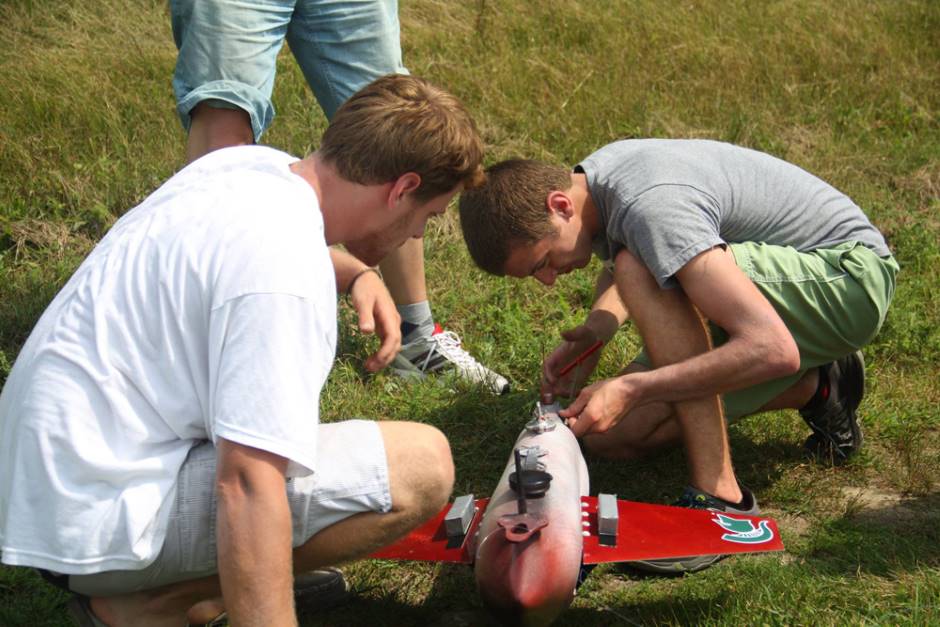Building Grace: Michigan State University’s Robotic Fish
 Students at work on the robotic fishbefore testing in Wintergreen Lake (Credit: Xiaobo Tan)
Students at work on the robotic fishbefore testing in Wintergreen Lake (Credit: Xiaobo Tan)In 2013, Dr. Xiaobo Tan debuted a high-tech robotic fish named Grace, which stands for “Gliding Robot ACE.” Grace is an updated version of the robofish that came before her. The waterborne contraption developed at Michigan State can move through the water and gather data that allows researchers to examine environmental conditions more closely. Early renditions of the fish were limited in their ability to travel and collect data. However, the 2013 model was able to glide through water practically indefinitely, all while gathering data and measuring water temperature, quality and relevant information.
Testing Grace: Robotic fish in Action
Dr. Xiaobo Tan designed and built the fish in order to aid fish researchers. The device has undergone multiple iterations, but the 2013 model signified a major shift. Early on, the fish was designed to swim by flapping its tail, an action that led to a swiftly depleted battery. The 2013 model was designed to glide through the water, meaning it can travel for much longer. The more efficient model still had its drawbacks, as the gliding fish was much slower and less maneuverable.
In a news release from MSU Today, Tan explains, “This is why we integrated both locomotion modes–gliding and swimming–in our robot,” Tan continues. “Such integration also allows the robot to adapt to different environments, from shallow streams to deep lakes, from calm ponds to rivers, with rapid currents.”
In 2012, Tan took Grace for a test swim on the Kalamazoo River, a site that suffered an oil spill in 2010. Grace swam at three locations along the river and wirelessly sent back sensor readings, states Tan to MSU Today. The deployment was groundbreaking, possibly setting a record for “Robotic fish-based sampling with commercial water-quality sensors in a real-world environment,” Tan explains.
In many ways, Grace is similar to an underwater glider in the way she moves through the water, but she has the added benefit of being about 10 times smaller and lighter than a commercial glider. A 2014 update of Grace distinguished the robotic fish from standard gliders even more substantially as she was equipped with receivers that detect the presence of fish implanted with acoustic-transmitting tags.
Using Robofish to Study Behaviors
A school of robofish were planned to be deployed in the Great Lakes to track the region’s most prized catches, reports MSU Today. The ultimate goal of the deployment was to track the movements of the fish and identify important habitats, understand why they move from one place to another, and how they are being affected by invasive species such as sea lampreys.
Compared to traditional acoustic fish tracking techniques, Grace provides a mobile receiver. Typically, data from tagged fish is received whenever the tag moves past a stationary receiver. Robotic fish provide a unique opportunity to have mobile receivers that gather data. The potential this has for fishery management is huge. Grace could be used to track fish as they navigate a region and simultaneously gather specific behavioral and environmental data.
Conclusion
One of the greatest benefits can be found in the price point. Underwater gliders that are used to detect tagged fish can be as much as $300,000 per unit—Grace will cost a fraction of the price. Dr. Xiaobo Tan has continued to develop Grace and test new models. Newer renditions focus on making Grace compatible with deep-water deployments while still being able to gather the same valuable data on fish behavior and environmental conditions. As her design becomes more comprehensive, Grace meets more and more monitoring needs.
So with changeable parts, researchers can measure important environmental parameters affecting fish, like the presence of blue-green algae, dissolved oxygen concentrations, light levels and water temperature. The improvements and acoustic capabilities will be used to study fish like Great Lakes trout and walleye.
Typical fish tracking involves stationary receivers that register the locations of fish when they swim by. Researchers want to refine that positioning accuracy by using multiple robots that can hear pings and interpret the locations of fish more precisely. Then the devices can be moved in advance to keep fish on the radar. The idea, Tan says, is to gather more data on fish behavior.
“We want to learn how fish move through water for days or weeks. We hope to understand their spawning behavior and daily routines,” said Tan. “Then managers can adjust accordingly.”


0 comments